How To Change Limits Of Integration From Cartesian To Polar
3.4: Double Integrals in Polar Form
- Page ID
- 580
Up until now, nosotros take dealt with double integrals in the Cartesian coordinate arrangement. This is helpful in situations where the domain can be expressed only in terms of \(x\) and \(y\). However, many issues are not and so like shooting fish in a barrel to graph. If the domain has the characteristics of a circle or cardioid, and then it is much easier to solve the integral using polar coordinates.
Introduction
The Cartesian system focuses on navigating to a specific betoken based on its distance from the x, y, and sometimes z axes. In polar form, there are generally ii parameters for navigating to a point: \(r\) and \( \theta \). \(r\) represents the magnitude of the vector that stretches from the origin to the desired point. In other words, \(r\) is the distance direct to that coordinate indicate. \( \theta \) represents the angle that the same theoretical vector would brand with the x-centrality. This creates a round type of move as we arrange the value of \( \theta \), which allows u.s. to express a circle of radius i every bit \( r = 1 \) as opposed to \( x^ii + y^2 = one \) in Cartesian coordinates.
Polar Double Integration Formula
Many of the double integrals that we have encountered so far take involved circles or at to the lowest degree expressions with \(x^2 + y^2\). When nosotros see these expressions a bell should ring and we should shout, "Can't nosotros use polar coordinates." The answer is, "Yeah" but only with intendance. Recollect that when we inverse variables in single variable integration such as \(u = 2x\), we needed to work out the stretching cistron \(du = 2dx\). The idea is similar with ii variable integration. When nosotros modify to polar coordinates, there volition as well be a stretching factor. This is axiomatic \since the expanse of the "polar rec\tangle" is not just every bit ane may expect. The picture is shown below.
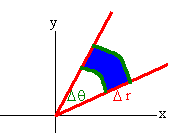
Fifty-fifty if \( \Delta{r}\) and \( \Delta{q}\) are very small, the area is not the product \( \Delta{r}\, \Delta{q} \). This comes from the definition of radians. An arc that extends \( \Delta{q}\) radians a altitude \(r\) out from the origin has length\( r\, \Delta{q}\). If both \(\Delta r\) and \(\Delta q\) are very minor so the polar rectangle has area
\[ Expanse = r \Delta{r} \Delta{q}. \nonumber \]
This leads us to the following theorem
Theorem: Double Integration in Polar Coordinates
Allow \(f(x,y)\) exist a continuous function divers over a region \(R\) bounded in polar coordinates by
\( r_1(q) < r < r_2(q) \) and \( q_1 < q < q_2 \).
Then
\[ \iint_R f(x,y)\,dy\,dx =\int_{\theta_1}^{\theta_2} \int_{r_1(\theta)}^{r_2(\theta)} f(r\cos \theta,r\sin \theta)\,r\,dr\,d\theta.\nonumber \]
Observe the actress "\(r\)" in the theorem
Theoretical discussion with descriptive elaboration
The area of a airtight and bounded region \(r\) in the polar coordinate airplane is given by
\[ A = \iint_{R}^{ }\ r \, dr\, d \theta. \nonumber \]
To find the premises for a domain in this course, we use a like technique as with integrals in rectangular form. Beginning at the origin with \(r = 0 \) we increment the value of \(r\) until nosotros find the maximum and minimum overall distance from the origin. Similarly, for \(\theta \) we start at \( \theta = 0 \) and discover the minimum and maximum angles that the domain makes with the orgin. The maximum distance abroad from the origin and the maximum angle with the origin that defines the boundary represents the upper leap for the double integral. The minimum distance and the minimum bending with the origin makes the lower spring for the double integral.
For instance, to find the bounds for \(r\), nosotros look to come across what the minimum and maximum overall distances from the origin are in terms of \(r\). Sometimes problems volition explicitly give you the curves that form the domain, other times you lot may need to wait at a graph to determine the domain. Regardless, if the origin is contained in the domain, then the lower bound for \(r\) volition exist 0. The upper bound will be whatever curve encompasses the rest of the domain.
\( \theta \) is unremarkably simpler to compute. The lower and upper premises are the minimum and maximum angles that the domain makes with the origin. Trigonometric functions can be used to decide the extreme angles that the part makes with the origin.
If an equation is provided, information technology is helpful to employ the conversions:
\[ x = r\, \cos \,\theta\nonumber \]
\[y = r\, \sin \,\theta \nonumber \]
to convert equations from Cartesian to polar form. If 1 must decide the premises from a provided graph, information technology can be helpful to estimate and check by plotting some test points to see if your bounds truly match the provided graph.
If you demand to convert an integral from Cartesian to polar class, graph the domain using the Cartesian premises and your cognition of curves in the Cartesian domain. Then use the method described above to derive the bounds in polar form. One time the integral is gear up, it may be solved exactly like an integral using rectangular coordinates.
Example \(\PageIndex{1}\)
Find the volume to the role of the paraboloid
\[ z = ix - ten^2 - y^2 \nonumber \]
that lies inside the cylinder
\[ 10^2 + y^2 = four. \nonumber \]
Solution
The surfaces are shown below.
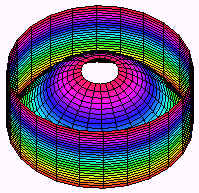
This is definitely a case for polar coordinates. The region \(R\) is the part of the xy-aeroplane that is inside the cylinder. In polar coordinates, the cylinder has equation
\[ r^ii = 4. \nonumber \]
Taking square roots and recalling that \(r\) is positive gives
\[ r = two. \nonumber \]
The inside of the cylinder is thus the polar rectangle
\( 0 < r < 2 \) \( 0 < q < ii\pi\).
The equation of the parabola becomes
\[ z = nine - r^2. \nonumber \]
We find the integral
\[ \int _0^{2\pi}\int_0^ii \left(9-r^2\right) r\,dr\,d\theta.\nonumber \]
This integral is a matter of routine and evaluates to \( 28\pi\).
Example \(\PageIndex{2}\)
Find the book of the office of the sphere of radius 3 that is left after drilling a cylindrical hole of radius two through the center.
Solution
The picture is shown below
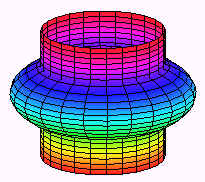
The region this fourth dimension is the annulus (washer) between the circles \(r = 2\) and \(r = 3\) as shown below.
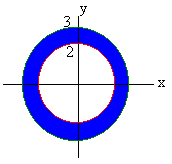
The sphere has equation
\[ x^2 + y^2 + z^two = 9 .\nonumber \]
In polar coordinates this reduces to
\[ r^2 + z^two = 9. \nonumber \]
Solving for \(z\) by subtracting \(r^2\) and taking a foursquare root we get superlative and lesser surfaces of
\[z=\sqrt{9-r^2} \;\;\; \text{and} \;\;\; z=-\sqrt{9-r^2}. \nonumber \]
Nosotros get the double integral
\[\int_0^{ii\pi} \int_2^3 (\sqrt{9-r^2}+ \sqrt{ix-r^2})r\; dr d\theta. \nonumber \]
This integral can be solved by letting
\[u = 9 - r^two \;\;\; \text{and} \;\;\;du = -2r\,dr.\nonumber \]
Afterwards substituting we get
\[\begin{align*} &-\dfrac{1}{two}\int_{0}^{ii\pi}\int_{5}^{0} 2u^{\frac{1}{2}} \; du d\theta \\ &= -\dfrac{2}{three}\int_{0}^{2\pi}[u^{\frac{3}{two}}]_5^0 \; d\theta \\ &= \dfrac{20 \sqrt{5} \pi}{three}.\cease{align*} \nonumber \]
Instance \(\PageIndex{3}\)
Change the Cartesian integral into an equivalent polar integral, then solve information technology.
\[ \int_{1}^{\sqrt{3}}\int_{1}^{x}dydx \nonumber \]
Solution
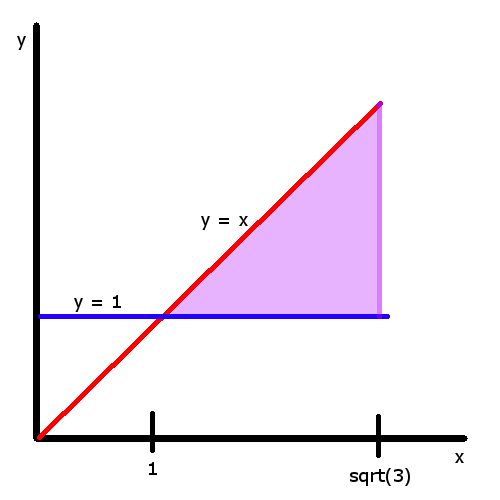
The betoken at (\(\sqrt{3}\), ane) is at an angle of \(\pi/6\) from the origin. The betoken at (\(\sqrt{three}, \sqrt{3}\) is at an angle of \(\pi/four\) from the origin. In terms of \(r\), the domain is bounded by 2 equations \(r=csc\theta\) and \(r=\sqrt{iii}\sec\theta\). Thus, the converted integral is
\[ \int_{csc\theta}^{\sqrt{three}\sec\theta}\int_{\pi/six}^{\pi/4}rdrd\theta. \nonumber \]
Now the integral tin can be solved just like any other integral.
\[\brainstorm{align*} &\int_{\pi/half-dozen}^{\pi/4} \int_{csc\theta}^{\sqrt{3}\sec\theta}rdrd\theta \\ & =\int_{\pi/6}^{\pi/four} (\dfrac{3}{ii} \sec^2\theta - \dfrac{1}{ii} \csc^2\theta) d\theta \\ & = \left [ \dfrac{three}{2} \tan\theta + \dfrac{1}{2}\cot\theta \right ] _{\dfrac{\pi}{half-dozen}}^{\dfrac{\pi}{4}} \\ & =2 - \sqrt{3}. \end{marshal*}\nonumber \]
Case \(\PageIndex{4}\)
Find the area of the region cutting from the first quadrant past the curve \( r = \sqrt{2 - \sin2\theta}\).
Solution
Note that information technology is not fifty-fifty necessary to draw the region in this case considering all of the information needed is already provided. Because the region is in the first quadrant, the domain is bounded past \( \theta = 0 \) and \( \theta = \dfrac{\pi}{2} \). The sole boundary for \(r\) is \(r = \sqrt{2 - \sin2\theta}\) so the integral is
\[\begin{align*} & \int_{0}^{\pi/two}\int_{0}^{\sqrt{2 - \sin2\theta}} rdrd\theta \\ &= \int_{0}^{\pi/2} \left [ \dfrac{r^2}{2} \right ] _{0}^{\sqrt{2 - \sin2\theta}} d\theta \\ &= \int_{0}^{\pi/2} \dfrac{two - \sin2\theta}{two} d\theta \\ &= \int_{0}^{\pi/2} 1 - \dfrac{\sin2\theta}{2} d\theta \\ &= \left [ \theta + \dfrac{\cos2\theta}{4} \right ] _{0}^{\pi/2} \\ &= \dfrac{\pi}{2} - \dfrac{1}{4}. \end{align*}\nonumber \]
Example \(\PageIndex{5}\)
Find the expanse of the region cutting from the outset quadrant by the bend \( r = \sqrt{2 - \sin2\theta}\).
Solution
Note that it is non fifty-fifty necessary to draw the region in this case because all of the information needed is already provided. Because the region is in the outset quadrant, the domain is divisional by \( \theta = 0 \) and \( \theta = \dfrac{\pi}{2} \). The sole boundary for \(r\) is \(r = \sqrt{2 - \sin2\theta}\) and then the integral is
\[\brainstorm{marshal*} & \int_{0}^{\pi/ii}\int_{0}^{\sqrt{2 - \sin2\theta}} rdrd\theta \\ &= \int_{0}^{\pi/2} \left [ \dfrac{r^2}{2} \right ] _{0}^{\sqrt{2 - \sin2\theta}} d\theta \\ &= \int_{0}^{\pi/2} \dfrac{two - \sin2\theta}{2} d\theta \\ &= \int_{0}^{\pi/2} 1 - \dfrac{\sin2\theta}{two} d\theta \\ &= \left [ \theta + \dfrac{\cos2\theta}{iv} \correct ] _{0}^{\pi/2} \\ &= \dfrac{\pi}{2} - \dfrac{1}{4}. \end{align*}\nonumber \]
Contributors and Attributions
- Michael Rea (UCD), Larry Green
-
Integrated by Justin Marshall.
Source: https://math.libretexts.org/Bookshelves/Calculus/Supplemental_Modules_(Calculus)/Vector_Calculus/3%3A_Multiple_Integrals/3.4%3A_Double_Integrals_in_Polar_Form
Posted by: baileythoseltogs.blogspot.com


0 Response to "How To Change Limits Of Integration From Cartesian To Polar"
Post a Comment